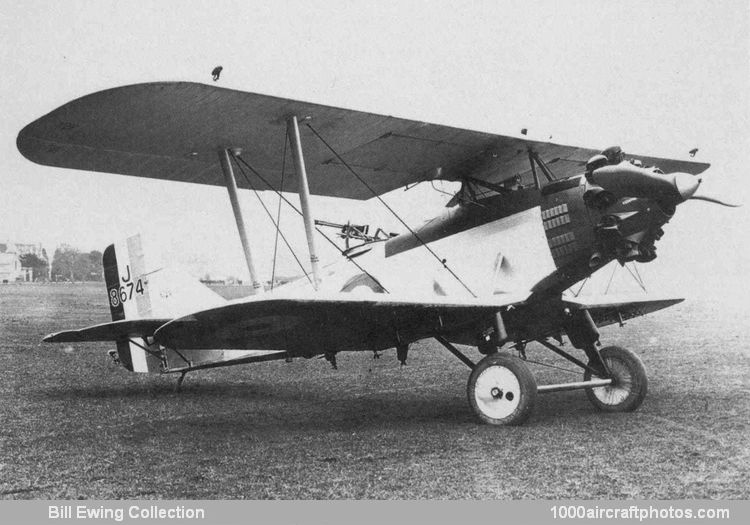12/15/2017. Remarks by Johan Visschedijk: "The Goring two-seat single-engined day bomber/torpedoplane designed principally by Captain S.J. Waters, Gloster Aircraft Company's assistant designer, under the supervision of Harry Folland, was a private venture project built at a cost of £7,000 in 1926 to meet specifications 23/25 and 24/25 and was intended as a potential replacement for the Hawker Horsley. The sole prototype, J8674, was flown as a landplane and as a seaplane and, although in appearance it was an orthodox and rather uninspiring single-bay biplane, it had very clean lines and it embodied many features gained from Folland's hard-earned experience with the racing seaplanes.
Constructed mainly in wood with steel fittings, the Goring was nevertheless designed with the ultimate use of an all-metal structure in mind. Ash longerons with spruce struts formed the rectangular fuselage structure which was wire-braced internally and had a top fairing built of ply formers and spruce stringers. The wing spars and ribs were spruce, and the structure was also wire-braced internally. The lower wings were attached to a small center section which curved upward to join the fuselage in a manner reminiscent of that used in the Gloster IV seaplane racer, and this feature not only improved the Goring's aerodynamic efficiency but also enabled a short robust main landing gear with a normal cross-axle to be used. To allow a torpedo to be carried to meet specification 24/25, a divided-axle type gear was also designed so that the Goring could operate in this alternative role.
A major design feature of the wings was their modified Joukowski airfoil section which gave a very high lift. Two 90 gal (341 l) gravity feed tanks were carried completely within the thick upper wing. All the control runs between the cockpit and the control surfaces were of swaged rods and were routed inside the wings and fuselage with chain and sprocket gear used only for changes in direction. The twin floats were built of anodized duralumin and were of a special Gloster design based on those used in the Gloster IV. An adjustable seat and rudder pedals were provided for the pilot, and the observer's seat could be stowed to enable him to operate his Vickers gun mounted on a Scarff ring, or to gain access to a bomb-sight or second gun position fitted in the floor of the rear cockpit.
The Goring was originally designed around the 470 hp Bristol Jupiter VII with a gear-driven supercharger, but on test this engine's unreliability and continual supercharger troubles led to its eventual abandonment for use in the Goring. Thus the design was modified to suit the 425 hp direct-drive Jupiter VI nine-cylinder air-cooled radial, driving a 12 ft 0 in (3.65 m) diameter Watts two-blade fixed-pitch wooden propeller. It was with this engine that J8674, having first appeared in March 1927, accomplished a good deal of flying. A change to the Bristol Orion was also foreshadowed, but because of the failure of this engine and its exhaust-driven supercharger, the Goring appeared in the New and Experimental Aircraft Park at the 1927 RAF Display at Hendon with a 460 hp Jupiter VIII geared radial engine fitted with a 12 ft 3 in (3.72 m) diameter Watts two-blade fixed-pitch wooden propeller.
In the following year J8674 went to Martlesham where its range and load-carrying abilities were highly praised. However, neither the Goring nor any of its three competitors, the Westland Witch, the Hawker Harrier and the Handley Page Hare, met the 23/25 requirements, a major contributory factor being the delay in the development of the supercharged Jupiter VII and X engines. In 1930 the Goring was back at Gloster for conversion to the seaplane configuration which included the fitting of an enlarged rudder, and during 1931 was extensively test flown from Calshot by Gloster test pilot Rex Stocken. At the completion of the trials which included full-load tests with underwing bomb racks, it reverted to a landplane powered by the 575 hp Jupiter XF and was fitted with new vertical tail surfaces of reduced area.
Subsequently J8674 was taken over by the Air Ministry and, like the Harrier, it was moved to Filton where, as a Bristol engine test bed, it led a useful life, fitted in turn with the following nine-cylinder air-cooled radials, the 745 hp Mercury VIIA, the 570 hp Pegasus II and the 670 hp Perseus lIL sleeve-valve engine.
It is rather ironic to recall that although none of the three competitors for the 23/25 contract was successful in winning production orders, two of these aeroplanes ultimately contributed to the development of variants of the Jupiter, the engine which led to their undoing. The third aircraft, the Witch, was used for parachute development work at Henlow."
